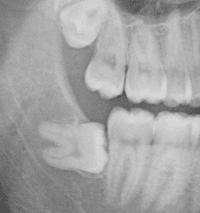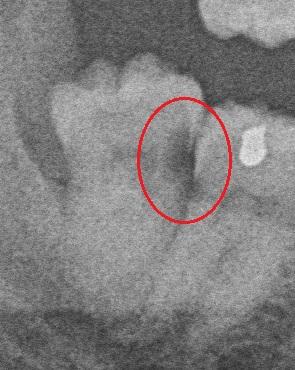
What are wisdom teeth?
Wisdom teeth are just a set of molars that erupt later in life (late teens to mid -20s or even older). Molars are the big chewing teeth towards the back of the mouth. Adults usually have 2 molars on each side of the mouth in the top and bottom jaws, hence 8 molars in total by the age of 15. The wisdom teeth or 3rd molars erupt later and are at the very back of the mouth.
Why are wisdom teeth a problem and need to be removed?
If the wisdom teeth come through normally, they are just like any other tooth and do not cause any issues. In that case, their removal is not necessary. However, there is sometimes not enough space behind the 2nd molars for the 3rd set of molars to erupt fully. They then come through the gums partially and remain stuck. The 3rd molars can also be angulated in such a way that they do not come up straight and then get stuck against the 2nd molars. In these cases, the 3rd molar is said to be ‘impacted’.
The following problems can arise from impacted 3rd molars:
- Infection and pain
Since they are still partly covered with gum tissue, it is not possible to clean them properly. Plaque accumulates under the gum flap and around the 3rd molar, causing an infection of the gum tissue which can become painful and swollen.

- Decay in the wisdom tooth itself as well as the tooth next to it
Decay can also develop in the 3rd molar and/or the 2nd molar due to the buildup of plaque under the gum flap covering the 3rd molar or between the 3rd and 2nd molars and inability to clean.

- Ulceration due to rubbing against adjacent soft tissues
The upper wisdom teeth coming down at an angle can also rub against the inside of the cheeks, causing ulceration and pain which in turn affect chewing and speaking.
- Cyst formation
Impacted wisdom teeth which are completely covered by gum tissue sometimes develop a sack of fluid or cyst around them. The cyst can lead to destruction of the bone around it and also damage the adjacent 2nd molar. Cysts can go undetected and if left for a long time, can grow quite large. This can lead to thinning of the jaw bone making a jaw fracture more likely.
In all the above situations, removal of the wisdom tooth causing the issue is the best treatment option
Other reasons for removal of the wisdom teeth
- Orthodontic treatment is required
In orthodontic treatment, sometimes the molars have to be moved backwards to make room so that the front teeth can be aligned. In this case, if the wisdom teeth are present, they will be in the way and need to be removed.
- The opposing wisdom tooth is not present
Most people have all 4 wisdom teeth- one on each side in each of the top and bottom jaws. However, in some cases, not all 4 might be present. Some patients have none at all, or only 2 or 3. In cases where there is a wisdom tooth in 1 jaw but not the other (e.g, present in the top jaw but not the opposing bottom jaw), the wisdom tooth can keep erupting and eventually rub against the gum directly above or below. This can lead to ulceration and pain and require removal of the wisdom tooth.
Do wisdom teeth cause the front teeth to become crowded?
People become concerned that over time they notice that their front teeth start looking crowded and believe it is because of the wisdom teeth coming through in the back and pushing on the front teeth. However, this is not the case. Erupting wisdom teeth do not exert enough force to cause all the other teeth to move forward.
The cause of front teeth becoming crowded over time is the gradual change in facial skeletal morphology as a result of normal aging. Removing the wisdom teeth does not prevent this from occurring.
How are wisdom teeth removed?
Wisdom teeth can be removed by a dentist with training in surgical techniques or by an oral-maxillofacial specialist surgeon.
The decision will depend on the experience of the dentist as well as the complexity of the case. Therefore, it is important to get a thorough case assessment with x-ray images and/or cone-beam CT scans if necessary.
When is removal of a wisdom tooth considered complex?
A case can be considered complex when
- the lower wisdom teeth have roots that are located close to the major nerve bundle running in the lower jaw and removal risks injuring these nerves.
- the wisdom teeth have very curved roots which could fracture easily during removal.
- the wisdom teeth are still buried quite deeply in the jaw bone and will require a lot of bone removal to be extracted
- the roots of the wisdom teeth in the upper jaw are projecting extensively into the sinus cavity and removal can lead to an opening connecting the sinus to the oral cavity. This can then cause a sinus infection.
What kind of anaesthesia is used for wisdom teeth removals?
Depending on the complexity of the case and the patient’s preference, wisdom teeth can be extracted under Local anaesthesia (LA) only or General anaesthesia (GA).
If LA is being used, the extraction site is numbed up with injections of local anaesthetic similar to when a filling is being done. The patient can be given a sedative orally or intravenously prior to the procedure. The patient is not fully unconscious, but the sedative reduces anxiety and awareness during the procedure.
If GA is used, the patient has to be seen in a hospital setting and the patient is unconscious during the procedure. LA is still given to the unconscious patient to prevent pain after the procedure.
What are the side-effects and possible complications of wisdom teeth removal?
Common side-effects are
- Post operative pain: this is normal after all extractions. Severity of pain will depend on the complexity of the case. Patients are usually prescribed strong painkillers for a few days after the procedure.
- Swelling and bruising: Swelling inside the mouth and of the face are common and usually subside within a few days. The same applies to bruising which can occur to the face. Swelling can affect mouth opening and make it difficult to eat. It is recommended to have a soft diet for a few days after the extraction of wisdom teeth.
- Bleeding: Some minor bleeding from the extraction sockets can still occur for a day after the procedure. The patient is usually provided with sterile gauze packs to place over the socket and is instructed to bite down on those to apply pressure. Continuous pressure forms a blood clot in the sockets which arrest the bleeding.
- Nausea and vomiting: If the wisdom teeth are removed under GA, a side-effect can be nausea and vomiting when awakening from the General Anaesthesia.
Possible Complications following wisdom teeth removal are
- Numbness and altered sensations affecting the face and inside the mouth and tongue: The lower wisdom teeth are sometimes positioned close to the nerves that supply sensation to the skin of the lower jaw, lower lip, chin and tongue. Damage to these nerves during removal of the wisdom teeth can lead to temporary or permanent numbness of these areas. The numbness is sometimes not complete but sensation is not fully recovered either.
- Pain from nerve damage: damage to the nerves can also lead to pain sensations in some cases. The pain is not due to the nerve fibres being injured and not healing properly. This kind of neuropathic pain is difficult to treat.
- Infection of the extraction sites: the gum and/or bone in the extraction sites can become infected. A post-operative infection must be treated with antibiotics prescribed only by your dental surgeon.
- Sinus infections: The roots of the upper wisdom teeth project into the sinus cavities. Extracting the upper wisdom teeth can lead to an opening between the sinus and mouth. This can lead to bacteria from the mouth entering the sinus and causing an infection. The infection must then be treated with antibiotics. If the opening is large, it has to be surgically corrected by a surgeon.
At the Melbourne Smile Clinic, we are your dentist in Northcote for your wisdom teeth concerns. We will carefully assess the complexity of your case with x-ray images and a thorough examination. The options will be discussed and we will also take into consideration your preference when it comes to anaesthesia. We are happy to refer our patients as necessary to a maxillofacial specialist surgeon for extraction of their wisdom teeth.

Located in Melbourne Inner North, The Melbourne Smile Clinic is your dentist for Northcote, Thornbury, Fairfield, Westgarth, Clifton Hill, Preston and surrounding suburbs.
For more information or for an appointment, contact us on 9078 4471 or send us a message here
